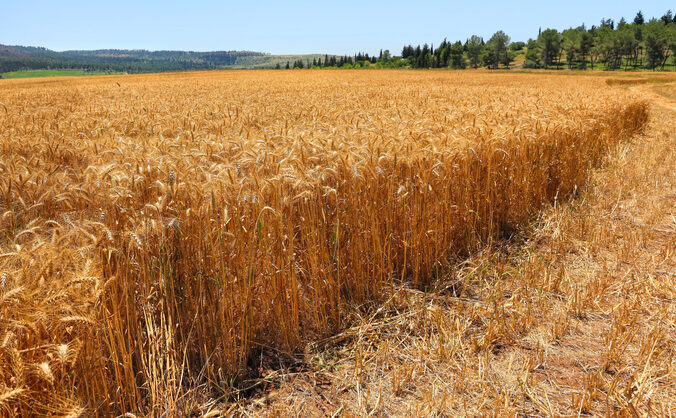By Jim Carlill & ICEJ Australia team

“So you shall keep the commandments of the LORD your God by walking in his ways and by fearing him. For the LORD your God is bringing you into a good land…a land of wheat and barley, of vines and fig trees and pomegranates, a land of olive trees and honey…” Deuteronomy 8:6-8
This promise must have been music to the Israelite ears after wandering around the desert for 40 years.
Barley which is mentioned many times in scripture enjoys the status of these six other crops that the LORD chose to mention out of all the food sources in the Land as one of the great blessings awaiting the Israelites when they entered the land of Canaan. They are referred to as the Seven Species and In Israel today ‘the seven species’ is a common motif and is displayed in many places – posters, place mats, decorations on pottery and plates. In some parks and gardens there is a ‘Seven Species’ corner.
Because barley was the first crop to be harvested after winter in the month of Aviv, meaning springtime in Hebrew, it has the added status of being a first fruits offering.

The Israelites were commanded to bring a sheaf of the first grain of the harvest, that is barley, to the priest during the Feast of Unleavened Bread immediately following the Passover. Leviticus 23:10, “Bring to the priest a sheaf of the first grain of your harvest”.
At the time of Jesus that always happened on the first day of the week, the day after the weekly Shabbat. As the barley was lifted up and waved before the LORD with the promise of harvest ahead, Jesus was raised from the dead.
The new harvest was not eaten until the wave offering was made.
A most important function of barley was to determine the beginning of the new year. The Hebrew calendar is based on 12 lunar months in a year, but because 12 lunar months is about 11 days short of a solar year, the Hebrews had to add an extra month every so often for their lunar calendar to coincide with the solar year. This was necessary as their agricultural culture was based on the solar year. The timing of this additional month was determined by the barley wave offering required after each Passover. If the barley was not ripe at Passover, a 13th month was added. This leap month occurred about every third year.
The barley harvest also began an important milestone for the Israelite farmer since it signified the beginning of a period of a very variable climate which could endanger the ensuing crops as spring transitioned into summer. Each of the Seven Species from which later first fruit offerings would come, had different levels of maturity during this period requiring different kinds of weather and temperatures at certain times. When the Israelites entered Canaan, they could be tempted to follow the custom of the Canaanites who looked to the local ‘gods’ they thought controlled different weather patterns, but the Israelites needed to look to the one true God who controls all.

This variable climatic period of 50 days from Pesach finished with the wheat harvest at the Festival of Shavuot which celebrated the first ingathering of the year’s harvest and when the farmer “shall come home with shouts of joy, bringing his sheaves with him,” Psalms 126:6.
Thus Passover and Shavuot were linked by the 50 day countdown beginning from the barley wave-offering. “From the day after the Sabbath, the day that you bring the sheaf of wave-offering, you shall keep count until seven full weeks have elapsed: you shall count fifty days until the day after the seventh week” (Leviticus. 23:15-21). The connecting period of 49 days is a spiritual reminder that Passover is only the beginning of a journey, it symbolises freedom from a sinful life, but there is more that God has for His people. Shavuot was not only the wheat harvest but remembers the giving of the Torah at Mt Sinai 50 days after leaving Egypt, when the ex-slaves learned to be a holy people.
During Shavuot the book of Ruth is studied because this lovely story is set against the backdrop of the grain harvests. “So she gleaned in the field until evening. Then she beat out what she had gleaned, and it was about an ephah of barley. … So she kept close to the young women of Boaz, gleaning until the end of the barley and wheat harvests,” Ruth 2:17,23.
Barley was very important to the Israelites because of its earlier maturing and also it could grow on a wider range of soils than wheat. For over 400 years after the Israelites entered Canaan, they mostly inhabited the hill country where there was a wide range of soils, whereas the lower more productive land was inhabited by the Philistines. Barley was the essential component of the Israelite’s diet at this time as it was used for making bread, porridge and barley cakes. It was the cheaper option for the poorer citizens.
Loaves of barley featured in one of Jesus’ amazing miracles in John 6:9: “There is a lad here who has five barley loaves and two small fish, but what are they among so many?”
Wheat was considered more palatable and the preferred grain, selling for twice the price of barley. “Then the people went out and plundered the camp of the Syrians. So a seah of fine flour was sold for a shekel, and two seahs of barley for a shekel, according to the word of the LORD,” 2 Kings 7:16.
Barley continues to be harvested in Israel for its nutritional benefits, including being a good source of fibre, vitamins, and minerals. Barley contributes to the country’s agricultural industry and the production of essential food and animal feed products.
We trust that this article has enriched your insights of the hurting nation nation of Israel. Click below to see what ICEJ is doing for a hurting nation in this project report.



